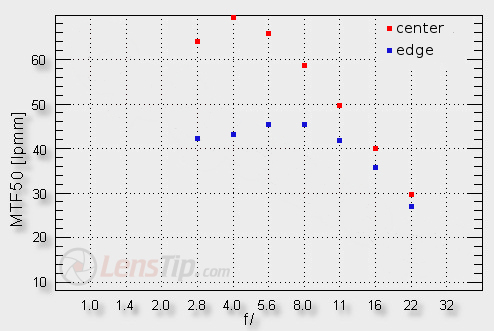Sigma 19 mm f/2.8 EX DN
4. Image resolution
It’s worth reminding here that, in the case of the tests on the E-PL1, the decency level is situated near 42 lpmm. So far the highest result among the system optical devices has been reached by the Leica DG MACRO ELMARIT 45 mm f/2.8 ASPH. MEGA O.I.S, which, by f/4.0 got to 80 lpmm. The results of Panasonic “pancakes” were a bit lower - the 1.7/20 model brushed against 75 mm and the wide-angle LUMIX G 14 mm f/2.5 ASPH exceeded slightly the level of 70 lpmm. You can also remind yourself here that the Sigma 30 mm f/2.8 EX DN, tested not so long ago, reached as high as 75 lpmm.
Let’s check how the Sigma 2.8/19 compares. A graph below will help you to assess it properly.
Please Support UsIf you enjoy our reviews and articles, and you want us to continue our work please, support our website by donating through PayPal. The funds are going to be used for paying our editorial team, renting servers, and equipping our testing studio; only that way we will be able to continue providing you interesting content for free. |
- - - - - - - - - - - - - - - - - - - - - - - - - - - - - - - - - - - - - - - - - - - - - - - -

It would be difficult to have any reservations concerning a lens which already at the maximum relative aperture reaches the result of 64 lpmm so a lot more than the decency level. It means that in the frame centre the tested Sigma gives you sharp images practically across the whole range of apertures (perhaps apart from f/22, where the diffraction becomes keenly felt). Everything would be very nice if only it wasn’t for the performance of its competitors. Firstly the 19 mm model fares still a bit worse than the 30 mm Sigma, tested not so long ago. What’s more, the results of the Sigma 2.8/19 are comparable to those of the Panasonic “pancakes” with the focal lengths of 14 mm and 20 mm. The Sigma is not a “pancake”, though, so its significant dimensions and f/2.8 aperture should oblige it to a better performance than that of “pancakes”, lenses full of compromises. However the price of Sigma can be an argument for the defence – after all it is significantly cheaper than any rival device and its results are still better than those of another of its immediate competitors, the Olympus 2.8/17.
The performance on the edge can be described in similar manner. On the one hand the lens reaches the decency level even at the maximum relative aperture so it would be difficult to have any serious reservations here. On the other hand when you stop down you don’t observe any significant image quality improvement and the final results remind you much more of those small “pancakes” than full-scale “primes”.
Finally let us present the crops taken from the centre of our test chart; they were saved as JPEG files along RAW files, used for the analysis, presented above.
 |






